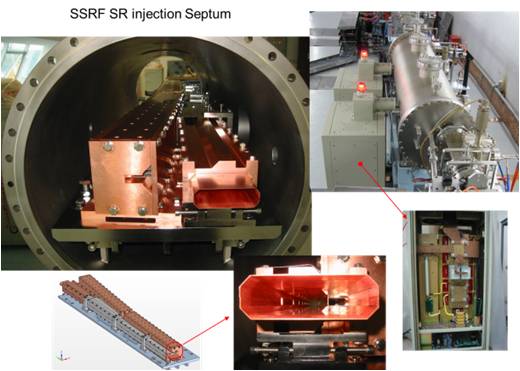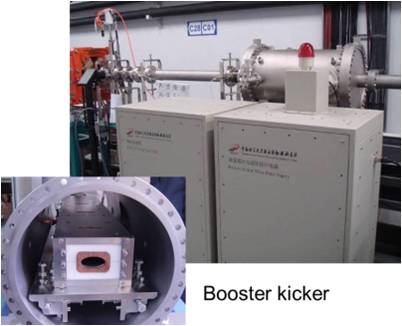The Pulse Technique group is responsible for design, implementation, operation and maintenance of the injection and extraction system for the SSRF booster and storage ring and the modulators for the SSRF Linac. The group is also in charge of design, assemble and test of pulsed magnets (septa and bump magnets), pulse power supplies and the
associated control systems.
The booster injection and extraction system consists of in-vacuum ferrite kicker magnets, eddy current septa and 200 ms bump magnets. The storage ring injection comprises four identical kickers with ceramic vacuum chamber and two septa with a sheet of magnetic screening material around the stored beam. For storage ring (SR) injection system,
septa are stressed on minimizing the leakage field, while kickers are emphasized on achieving the best possible
tracking in time and amplitude of the magnetic field waveforms so that the residual closed orbit disturbance is minimized for top-up injection. Since the SSRF opened in May 2009, high reliability and efficiency of the injection and extraction system have been achieved.
The septum is eddy current shielded type which was developed in-house with minimization of the leakage field. Lengthways axis of the core is designed to follow the beam trace, which can maximize the beam aperture and increase the thickness of shielding sheet. The magnet is excited with a 60 micro-second pulse of half sine wave from the pulsed power supplies. Moreover, a magnetic screen is placed around the stored beam to minimize the septum leakage field. Magnetic field measurement was conducted with both point coil and long integral coil, and the results show that at the maximum bumped beam position the leakage field was less than 0.01% (50 μT·m) of main field (710 mT and 800 mm).
Since December 2012, SSRF has operated in top-up injection mode, and the high reliability and effectiveness of the injection and extraction system and the Linac modulator have performed.
The group is currently composed of 10 members.
|
Name
|
Email
|
|
Ming Gu
|
guming@sinap.ac.cn
|
|
Zhihao Chen
|
chenzhihao@sinap.ac.cn
|
|
Qibin Yuan
|
yuanqibin@sinap.ac.cn
|
|
Yonghua Wu
|
wuyonghua@sinap.ac.cn
|
|
Ruiping Wang
|
wangruiping@sinap.ac.cn
|
|
Xiaoxuan Zhou
|
zhouxiaoxuan@sinap.ac.cn
|
|
Longsheng Xiao
|
xiaolongshen@sinap.ac.cn
|
|
Hailian Zhan
|
zhanhailian@sinap.ac.cn
|
|
Yongfang Liu
|
liuyongfang@sinap.ac.cn
|
|
Jin Tong
|
tongjin@sinap.ac.cn
|





 Copyright©2006.12 Shanghai Advanced Research Institute.
Copyright©2006.12 Shanghai Advanced Research Institute.